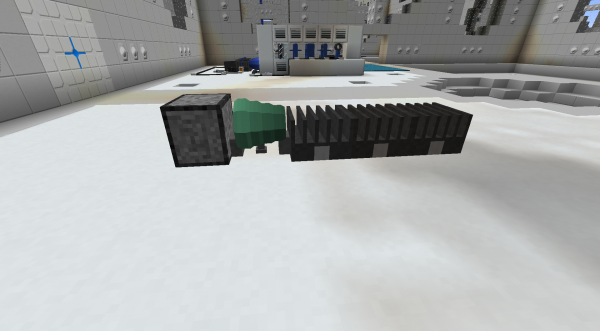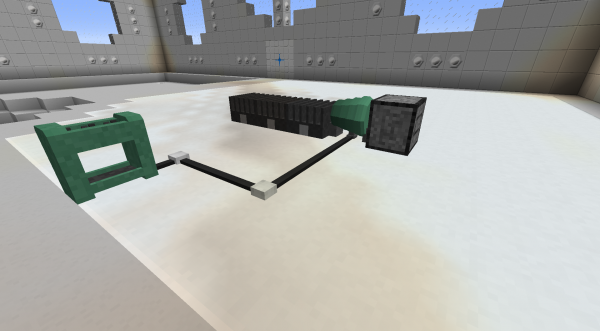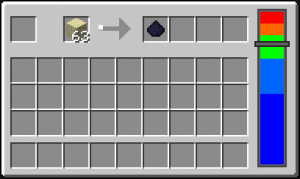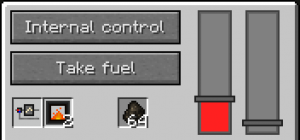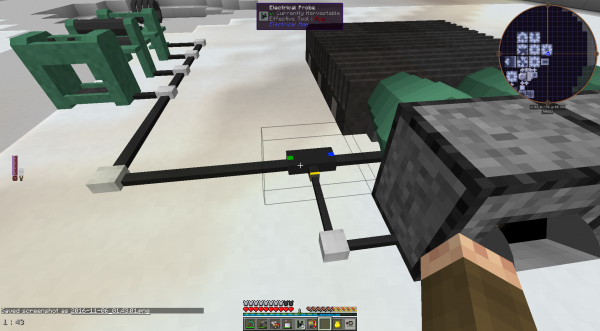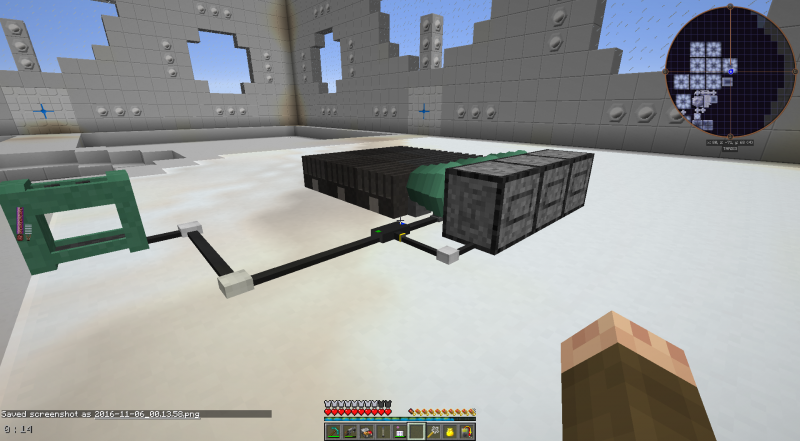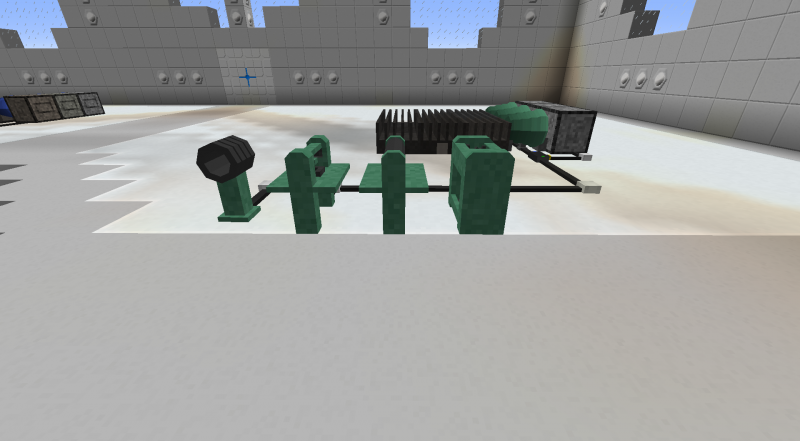Difference between revisions of "50V example build"
(Format images, change some sentences, etc. Changed content until `External control`) |
(Complete formatting) |
||
| Line 3: | Line 3: | ||
It's required for obtaining advanced elements which are needed for 200V+ systems. | It's required for obtaining advanced elements which are needed for 200V+ systems. | ||
| − | == Setup== | + | == Setup == |
A [[50V Heat Turbine]] generates power by exploiting the temperature difference between a hot side and a cold side. | A [[50V Heat Turbine]] generates power by exploiting the temperature difference between a hot side and a cold side. | ||
Hot side is marked with a red square, cold with a blue one. | Hot side is marked with a red square, cold with a blue one. | ||
| Line 11: | Line 11: | ||
[[File:Example_50V_1.png|600px]] | [[File:Example_50V_1.png|600px]] | ||
| − | [[File: | + | [[File:Stone_Heat_Furnace_Interface.png|thumb|[[Stone Heat Furnace]] interface]] |
| − | A furnace can take up to 2 [[Combustion Chamber]]s to improve efficiency. Valid fuels for the furnace | + | A furnace can take up to 2 [[Combustion Chamber]]s to improve efficiency. Valid fuels are the same as for the vanilla furnace. |
| − | |||
| − | |||
| − | |||
| − | |||
| − | |||
In our example, we will use Charcoal, since it's a very common solid fuel. | In our example, we will use Charcoal, since it's a very common solid fuel. | ||
| Line 26: | Line 21: | ||
== Using machines == | == Using machines == | ||
| − | [[File: | + | [[File:Macerator-Interface.png|thumb|Macerator Interface|right]] |
For the optimal performance, keep the voltage supply bar in the green area, by using the Control Gauge in the heat furnace.<br /> | For the optimal performance, keep the voltage supply bar in the green area, by using the Control Gauge in the heat furnace.<br /> | ||
If you do this by hand, that can take quite some work! Move to the next section for the automatic way. | If you do this by hand, that can take quite some work! Move to the next section for the automatic way. | ||
| Line 40: | Line 35: | ||
== Analogic control == | == Analogic control == | ||
| + | [[File:Stone-Heat-Furnace-with-Analogic-Control.png|300px|thumb|right|Stone Heat Furnace with analogic control]] | ||
Instead of controlling the temperature by hand, you can use an [[Analogic Regulator]] to keep it steady. | Instead of controlling the temperature by hand, you can use an [[Analogic Regulator]] to keep it steady. | ||
| − | |||
| − | |||
Use the Temperature gauge to set what temperature you want. 250-300 degrees corresponds to roughly | Use the Temperature gauge to set what temperature you want. 250-300 degrees corresponds to roughly | ||
| Line 50: | Line 44: | ||
== External control == | == External control == | ||
| + | [[File:Electrical-Probe-50V-Example.png|300px|thumb|right|[[Electrical Probe]] example for 50V build]] | ||
| + | Alternately, we can control the furnace by directly measuring the voltage on the line and adjusting temperature automatically. | ||
| − | + | # Right click on the [[Electrical Probe]] and set measurement to '''Voltage''' (default) | |
| + | # In the firs input field (100% output) set the value to <code>50</code> | ||
| + | # In the second input field (0% ouput) set the value to <code>0</code> | ||
| + | # Place a single [[Low Voltage Cable]] in the bottom right corner of the probe interface (so that it connects with the rest of the wire) | ||
| + | # Connect the probe to the furnace using a [[Signal Cable]] | ||
| + | # Set the Heat furnace to accept External Control (click once on the button labeled Internal Control) | ||
| − | + | Image of your build after this step is completed: | |
| − | |||
| − | |||
| − | |||
| − | [[File:Example_50V_7.png| | + | [[File:Example_50V_7.png|600px]] |
| − | |||
| − | This should keep wire voltage neatly at ~50V. Use of External control is important | + | This should keep wire voltage neatly at ~50V. Use of External control is important in more complex builds. |
| − | in more complex builds. | ||
== Finish == | == Finish == | ||
| − | We can expand out our heat furnaces and heat turbines, so that there are 3 in a row | + | We can expand out our heat furnaces and heat turbines, so that there are 3 in a row. |
| − | This is the maximum | + | This is the maximum that can safely be put on a single 50V wire without over-powering it. |
(It can sometimes make sense to add more, but that may need more sophisticated control) | (It can sometimes make sense to add more, but that may need more sophisticated control) | ||
| − | * Heat turbines allow electricity to pass | + | * Heat turbines allow electricity to pass between them (so no separate cables are required) |
| − | * Heat furnaces allow a signal to pass | + | * Heat furnaces allow a signal to pass between them too (so no extra signal wires are needed). |
[[File:Example_50V_9.png|800px]] | [[File:Example_50V_9.png|800px]] | ||
| − | Finally, we add the other machines | + | Finally, we add the other machines needed to continue with next tutorials. |
[[File:Example_50V_10.png|800px]] | [[File:Example_50V_10.png|800px]] | ||
| Line 87: | Line 83: | ||
| − | You can consider adding [[Machine Booster]]s to make your machines faster, | + | You can consider adding [[Machine Booster]]s to make your machines faster, but be careful not to draw too much power though! |
| − | be careful not to draw too much power though! | ||
== Where to go next == | == Where to go next == | ||
Revision as of 22:03, 28 December 2016
This is a first system that a survival mode player will make.
It's required for obtaining advanced elements which are needed for 200V+ systems.
Setup
A 50V Heat Turbine generates power by exploiting the temperature difference between a hot side and a cold side. Hot side is marked with a red square, cold with a blue one.
We can use a Stone Heat Furnace to provide the heat to the hot side, and couple Small Thermal Dissipaters for the cold side.
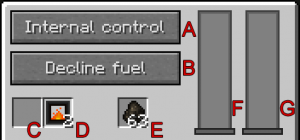
A furnace can take up to 2 Combustion Chambers to improve efficiency. Valid fuels are the same as for the vanilla furnace.
In our example, we will use Charcoal, since it's a very common solid fuel.
After setting up furnace, we'll hook up a 50V Macerator using Low Voltage Cable.
Using machines
For the optimal performance, keep the voltage supply bar in the green area, by using the Control Gauge in the heat furnace.
If you do this by hand, that can take quite some work! Move to the next section for the automatic way.
For this example, we will use a 50V Macerator, but the process is the same for all other machines.
If you add some load to the macerator (for example, sand), you'll need to increase heat produced by furnace.
After you remove the load, furnace will make too much heat and something will explode.
So, you will need to decrease the heat.
You can also know if macerator is in the optimal voltage by listening to the sound it makes.
The volume and pitch can tell you if the macerator is running at the optimal rate.
Analogic control
Instead of controlling the temperature by hand, you can use an Analogic Regulator to keep it steady.
Use the Temperature gauge to set what temperature you want. 250-300 degrees corresponds to roughly 50V in our case. The Analogic regulator will use the Control gauge to try to keep the temperature as close as possible to the desired temperature (called "set point").
External control
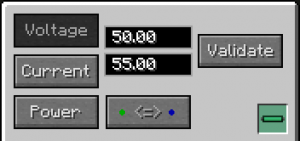
Alternately, we can control the furnace by directly measuring the voltage on the line and adjusting temperature automatically.
- Right click on the Electrical Probe and set measurement to Voltage (default)
- In the firs input field (100% output) set the value to
50 - In the second input field (0% ouput) set the value to
0 - Place a single Low Voltage Cable in the bottom right corner of the probe interface (so that it connects with the rest of the wire)
- Connect the probe to the furnace using a Signal Cable
- Set the Heat furnace to accept External Control (click once on the button labeled Internal Control)
Image of your build after this step is completed:
This should keep wire voltage neatly at ~50V. Use of External control is important in more complex builds.
Finish
We can expand out our heat furnaces and heat turbines, so that there are 3 in a row. This is the maximum that can safely be put on a single 50V wire without over-powering it.
(It can sometimes make sense to add more, but that may need more sophisticated control)
- Heat turbines allow electricity to pass between them (so no separate cables are required)
- Heat furnaces allow a signal to pass between them too (so no extra signal wires are needed).
Finally, we add the other machines needed to continue with next tutorials.
These are, from left to right:
You can consider adding Machine Boosters to make your machines faster, but be careful not to draw too much power though!
Where to go next
In theory, you should be able to make parts for any of the other Examples. At 50V that is going to take some time though.
After you make enough Alloy Plates, Advanced Motors and Advanced Machine Blocks, you can move on to 200V example build.
